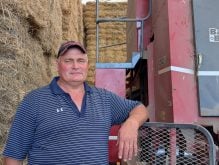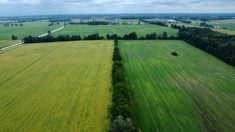Improving the resilience of Canadian agriculture requires more flexible and targeted conservation and safety net programming, according to doctoral and distinguished fellows with the Canadian Agri-Food Policy Institute.
They discussed their recent policy papers on what Canadian agriculture needs for economic stability and productivity in a recent webinar.
Courtney Anderson, Dislène Sossou, and Andu Berha discussed the financial benefits and challenges of adopting soil conservation practices, the impact of climate change on agricultural production, and how federal and provincial farm insurance programs are – or are not – mitigating these effects.
Read Also

Defence investments could benefit agriculture
A bump in Canada’s NATO spending commitments could lead to infrastructure investments that would benefit rural areas
Impact of land values
Anderson took a high-level look at the economics of farmland use – including returns from farmland compared to land purchase and rental costs – and what rising farmland values means for the longevity of the sector.
Overall, Anderson reaffirms Canada’s farmland is currently in “long-term decline” from development and other pressures, that farmland rental rates have caught up to farmland value appreciation in most areas of the country, and that appreciation in the value of most farmland alone “does not provide a high enough all-in discount rate of return for most investors.”
Farmland rentals, says Anderson, offer a strong potential additional return on investment to those owning farmland, but come at considerable risk and uncertainty for the renter. Speaking during the CAPI event, he says statistical data indicates rental costs siphon some 90 per cent of operator income, leaving only 10 per cent to cover all other production expenses. This, he says, indicates strong competition in farmland rental markets.
Given the competition for farmland, Anderson argues a better understanding of what future generations will require to invest in farming – whether through renting, purchasing, or other methods of farm investment – is needed. He also points to policies from different regions across the country, which have restricted land ownership, as possible models by which farmland can be conserved in other areas.
What drives adoption of new practices
Sossou’s research focused on what drives the adoption of more environmentally-minded production practices in vegetable systems, something she says is ever more important as consumer demand for domestically grown produce spurs growth in the vegetable sector.
Because vegetable production often necessitates the intensive use of inputs, tillage, and other elements of production mechanization, says Sossou, soil health degradation is a growing concern. The adoption of soil conservation practices helps remediate these issues, while often reducing production costs for the farmer.
However, many vegetable farmers are still reluctant to adopt soil conservation practices due to financial constraints, implementation challenges, access to information, market access, non-targeted support, and general negative perceptions of some practices.
These perceptions are not necessarily unwarranted, given economic and environmental goals don’t always align on the farm. Sossou details how “there is a potential tension between economic sustainability (via succession planning) and environmental sustainability (via Environmental Farm Plans),” adding policymakers or advisors “need to balance both objectives when designing conservation programs.” Policies promoting the adoption of soil conservation practices should also account for farmer crop specialization – including recognition of the soil nutrient requirements for the vegetable in question.
Additional recommendations to increase the adoption of effective soil conservation practices include expanding technical assistance and market access for vegetables demanding particularly high levels of soil nutrients, enhancing supply chain integration and connecting farmers with wholesalers or processors preferring vegetables grown with soil conservation practices, designing irrigation and incentives policies for a balanced land-use strategy, and implementing policies to sustain an effective workforce for labour-intensive crops.
Different farms, different insurance programs
Berha’s work highlights how a one-size-fits-all approach to production insurance programs is increasingly costly, as well as ineffective at promoting change on the farm.
When the climate is good – that is, when poor and extreme weather has not been the norm – Berha says farmers tend to specialize in a few high-performance crops, in pursuit of high returns. This occurs at the expense of greater crop diversity, which while often being less profitable overall, helps protect farmers in the face of an unfavourable climate. Diversification only happens after the onset of poor conditions.
There is thus “a clear trade-off” between sustainability and productivity, says Berha. The imbalance in that trade-off is costing farmers and insurers a lot of money, with Canadian farm insurance payouts jumping from $1.9 billion in 2018 to nearly $5.7 billion five years later – a cost surge that has occurred alongside more extreme weather.
A means of reducing insurance costs involved is complimenting current business risk management programs with “resilience bult in.” This would include promoting climate-resilient crop choices and farming practices, as well as addressing different risks faced by farmers in different regions.
Berha identifies four additional means of improving insurance programing. This includes a guarantee of prompt payouts to meet cash flow needs, scaled coverage to better match losses – special mention is also given to the upward adjustment of coverage caps and top-ups to reflect greater risk during more extreme weather – simplified paperwork processes, and greater transparency through the publishing of an annual business risk management performance dashboard, which includes reporting payout times, approval rates, and regional uptake.
Courtney Anderson, Dislène Sossou, and Andu Berha’s full analyses are available via the Canadian Agri-Food policy Institute’s website.















